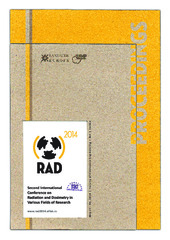| dc.creator | Maletić, Dimitrije | |
| dc.creator | Ajtić, Jelena | |
| dc.creator | Đurđević, V. | |
| dc.creator | Todorović, Dragana | |
| dc.creator | Nikolić, J. | |
| dc.creator | Banjanac, R. | |
| dc.creator | Udovičić, V. | |
| dc.date.accessioned | 2020-06-03T13:51:48Z | |
| dc.date.available | 2020-06-03T13:51:48Z | |
| dc.date.issued | 2014 | |
| dc.identifier.issn | 2466-4626 | |
| dc.identifier.uri | https://vet-erinar.vet.bg.ac.rs/handle/123456789/1149 | |
| dc.description.abstract | Activities of lead-210 and beryllium-7 have been monitored at the Vinča Institute of Nuclear Sciences in Belgrade, Serbia. The monthly mean activities in composite aerosol samples were determined on HPGe detectors by standard gamma spectrometry. The meteorological data, consisting of the temperature, atmospheric pressure, relative humidity, sunshine hours and cloud cover data were obtained from the European Climate Assessment & Dataset and the Republic Hydrometeorological Service of Serbia. Five teleconnection indices of large scale atmospheric circulation: North Atlantic Oscillation, East Atlantic Pattern, East Atlantic/West Russia Pattern, Scandinavia Pattern, and Polar/Eurasia Pattern were obtained from the data archive of the United States National Oceanic and Atmospheric Administration's Climate Prediction Center. The first lead-210 and beryllium-7 activities measured at the Vinča Institute date back to 1985 and 1991, respectively, and their relation with the climate variables and teleconnection indices is investigated using multivariate methods of analysis. The most appropriate multivariate method of analysis of these sets of measurements is selected from a wide spectrum of multivariate methods developed for data analysis in high-energy physics and implemented in the Toolkit for Multivariate Analysis software package. The evaluation ranking results based on the best signal efficiency and purity, show that the Boosted Decision Trees (BDT) multivariate method is the most suitable for the variable analysis. Further multivariate analysis results give insight into the dependence of lead-210 and beryllium-7 concentrations upon the climate variables and atmospheric circulation (via the teleconnection indices) during the time of measurements. The BDT method singles out the Scandinavia Pattern index as the variable with the highest importance for both radionuclides. Amongst the climate variables, temperature shows the strongest influence on the radionuclide concentrations, while relative humidity is the lowest ranking variable. Moreover, the multivariate regression methods give a good approximation of lead-210 and beryllium-7 concentrations for all the sets of climate variables and teleconnection indices. | en |
| dc.publisher | RAD Association | |
| dc.relation | info:eu-repo/grantAgreement/MESTD/Integrated and Interdisciplinary Research (IIR or III)/43007/RS// | |
| dc.rights | openAccess | |
| dc.source | RAD Conference Proceedings | |
| dc.subject | Air | en |
| dc.subject | Be-7 | en |
| dc.subject | Climate variables | en |
| dc.subject | Lead-210 | en |
| dc.subject | Multivariate methods | en |
| dc.subject | Teleconnection indices | en |
| dc.title | Multivariate analysis of climate variables, teleconnection indices and activities of lead-210 and beryllium-7 in surface air in Belgrade, Serbia | en |
| dc.type | conferenceObject | |
| dc.rights.license | ARR | |
| dcterms.abstract | Бањанац, Р.; Тодоровић, Д.; Николић, Ј.; Ђурђевић, В.; Aјтић, Јелена; Удовичић, В.; Малетић, Димитрије; | |
| dc.citation.spage | 13 | |
| dc.citation.epage | 16 | |
| dc.citation.other | : 13-16 | |
| dc.identifier.scopus | 2-s2.0-85057711011 | |
| dc.identifier.fulltext | http://veterinar.vet.bg.ac.rs/bitstream/id/7086/bitstream_7086.pdf | |
| dc.identifier.rcub | https://hdl.handle.net/21.15107/rcub_veterinar_1149 | |
| dc.type.version | publishedVersion | |

